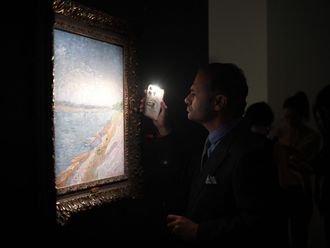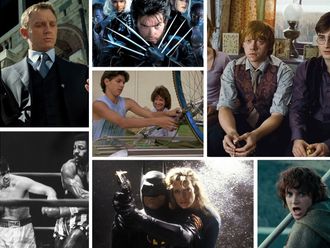In her Tokyo studio, Yayoi Kusama paints an arc in exactly the same vibrant red colour as the wig she is wearing. Since childhood, Kusama has made art to help her deal with her serious psychological problems. These include terrifying hallucinations of what she calls "self-obliteration" in which she feels the boundary between herself and the universe suddenly melting away. Brush in hand, the 82-year-old artist works without the slightest hesitation; this is one domain over which she has absolute control.
Kusama was famous in New York in the 1960s, but she was almost completely forgotten as an artist after she moved back to Japan in the 1970s and checked into the psychiatric hospital where she still lives. Now her star is once again in the ascendant. In 2008 one of her works sold for $5.8 million at auction, then the second-highest price for a work by a living female artist. Now a solo retrospective show is touring some of the world's best museums. Acclaimed in Madrid at the Reína Sofia and in Paris at the Centre Pompidou, the exhibition opened this month at London's Tate Modern and will travel to the Whitney Museum in New York in July.
Kusama has made at least two significant contributions to the history of post-war art. In the late 1950s, shortly after moving to New York, she made large abstract works in which white loops of hand-painted mesh keep a black background at bay. At first glance these canvasses look like flat monochromes, but a longer gaze suggests that they are undulating oceans of dots. These works were a riposte to abstract-expressionist pictures, such as Jackson Pollock's "drip" paintings; the compositions were more radical and the process of producing them more intense. Most important was the fact that Kusama's abstractions announced the arrival of the next notable art movement, minimalism.
These paintings, which Kusama called "Infinity Nets", helped her protect herself from the "void" she most feared. In 1961 she created an "Infinity Net" that measured 33 feet (10 metres) across, an obsessive work that betrayed the scale of both her need and her ambition. Kusama has never stopped making "Net" paintings, although these now come in a range of colours. Her endless series is a forerunner of Damien Hirst's never-ending production of spot paintings.
Kusama was also ahead of her time in creating installation art. In 1963 Aggregation: One Thousand Boats Show at the Gertrude Stein gallery featured a rowing boat filled with phallic sculptures installed in a room papered with 999 black-and-white photographic reproductions of the work. This surreal Pop piece was influential in the way it took art outside the frame and invaded a whole room.
Three years later, in 1966, Andy Warhol imitated her treatment of walls with his Cow Wallpaper. About Warhol, Kusama has said: "We were like rival gang leaders, enemies in the same boat."
Kusama went on to make Infinity Mirror Rooms. The most recent of these have hundreds of little lights that are reflected by the mirrored walls and ceiling and the water on the floor. Kusama seems to be translating her inner terrors into works that inspire feelings of awe, elation and plenitude. Viewers who step into these boxes have the sense of being physically at the centre of a beautiful universe.
In the late 1960s Kusama started creating performances that brought her fame and disrepute in equal measure. Called Body Paint Festivals or Self-Obliteration Happenings, these events consisted of naked dancing hippies (who were often covered in polka dots) burning flags. It was not a high point in her career — at least not aesthetically.
If there is one thing that Kusama has never feared, it is the limelight. She looks extraordinary, often wearing clothes that blend in with her artworks to the extent that she becomes a part of them. The artist begins each working day by reviewing her press clippings. Some people view the media as a curse. For Kusama media coverage is an instant, if short-term, panacea against her fears of self-annihilation. It's as if her media image helps her reaffirm her sense of self.
Many women artists wait a long time for accolades. The advantage of late recognition is that it can spur them to new heights. Louise Bourgeois did some of her best work in her 80s. Kusama aspires to do the same. The announcement of the Tate retrospective somehow "flicked a switch in her," says Glenn Scott Wright, director of the Victoria Miro gallery, Kusama's European dealer. Indeed, the artist has made more than 140 paintings in the past two years alone.
Painted on a table that she can approach from all four sides, the new canvasses have a fantastic variety of compositions, vivacious colours and poetic titles. They feel like Kusama's most overtly personal work so far. As artists grow old, they often make lifeless pastiches of their early work, but Kusama has embarked on something fresh and audacious. "Death is just around the corner and I am not yet sure I'm a great artist," she explains. "That is why I am absorbed in painting."
Yayoi Kusama is on at Tate Modern in London until June 5 and at the Whitney Museum of American Art from July 12 to September 30.












